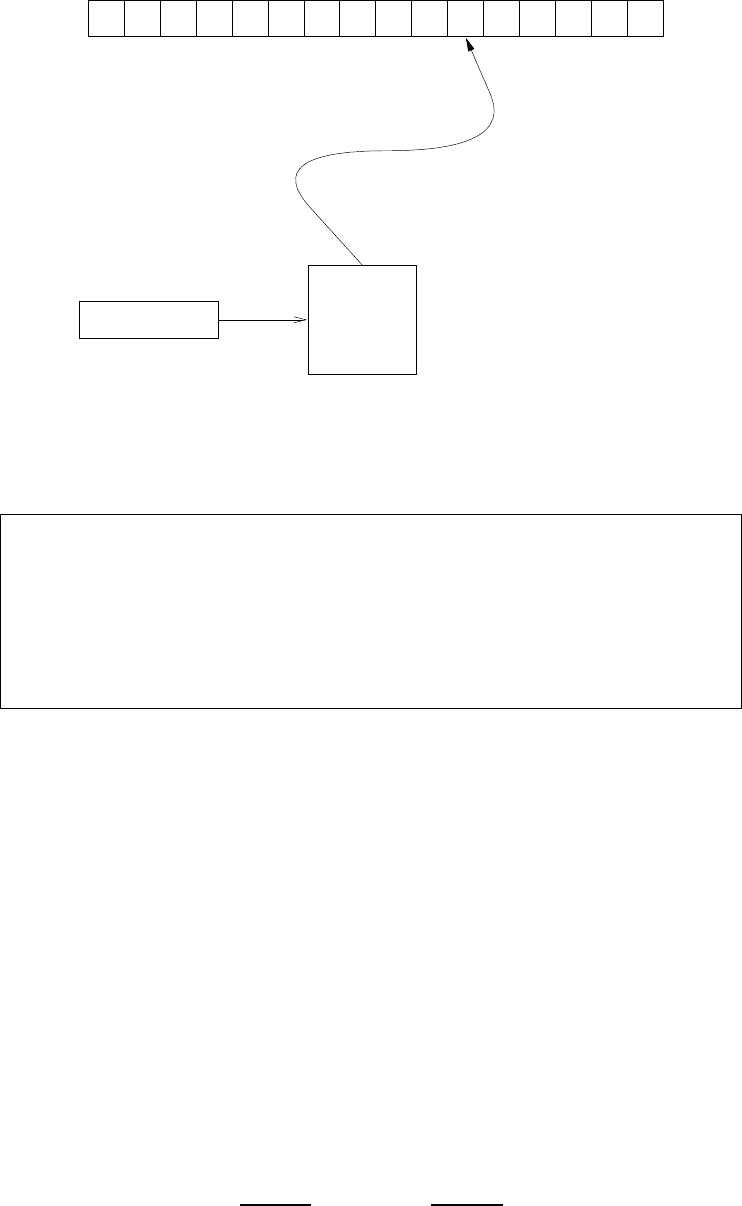Goldreich O. Computational Complexity. A Conceptual Perspective
Подождите немного. Документ загружается.


CUUS063 main CUUS063 Goldreich 978 0 521 88473 0 March 31, 2008 18:49
9.2. ZERO-KNOWLEDGE PROOF SYSTEMS
zero-knowledge can be used to prove membership in any NP-set. Intuitively, it suffices
to establish this fact for a single NP-complete set, and thus we focus on presenting a
zero-knowledge proof system for the set of 3-colorable graphs.
It is easy to prove that a given graph G is 3-colorable by just presenting a 3-coloring
of G (and the same holds for membership in any set in NP), but this NP-proof is not
a zero-knowledge proof (unless NP ⊆ BPP ). In fact, assuming NP ⊆ BPP, graph
3-colorability has no zero-knowledge NP-proof system. Still, as we shall shortly see,
graph 3-colorability does have a zero-knowledge interactive proof system. This proof
system will be described while referring to “boxes” in which information can be hidden
and later revealed. Such boxes can be implemented using one-way functions (see, e.g.,
Theorem 9.11).
Construction 9.10 (Zero-knowledge proof of 3-colorability, abstract description):
The description refers to abstract non-transparent boxes that can be perfectly locked
and unlocked such that these boxes perfectly hide their contents while being locked.
• Common Input: A simple graph G =(V, E).
• Prover’s first step: Let ψ be a 3-coloring of G. The prover selects a random
permutation, π , over {1, 2, 3}, and sets φ(v)
def
= π (ψ(v)), for each v ∈ V . Hence,
the prover forms a random relabeling of the 3-coloring ψ. The prover sends to
the verifier a sequence of |V | locked and non-transparent boxes such that the v
th
box contains the value φ(v).
• Verifier’s first step: The verifier uniformly selects an edge {u,v}∈E, and sends
it to the prover.
• Motivating Remark: The boxes are supposed to contain a 3-coloring of the graph,
and the verifier asks to inspect the colors of vertices u and v. Indeed, for the
zero-knowledge condition, it is crucial that the prover only responds to pairs that
correspond to edges of the graph.
• Prover’s second step: Upon receiving an edge {u,v}∈E, the prover sends to the
verifier the keys to boxes u and v.
For simplicity of the analysis, if the verifier sends {u,v} ∈ E then the prover
behaves as if it has received a fixed (or random) edge in E, rather than suspending
the interaction, which would have been the natural thing to do.
• Verifier’s second step: The verifier unlocks and opens boxes u and v, and accepts
if and only if they contain two different elements in {1, 2, 3}.
The verifier strategy in Construction 9.10 is easily implemented in probabilistic polyno-
mial time. The same holds with respect to the prover’s strategy, provided that it is given
a 3-coloring of G as auxiliary input. Clearly, if the input graph is 3-colorable then the
verifier accepts with probability 1 when interacting with the prescribed prover. On the
other hand, if the input graph is not 3-colorable, then any contents put in the boxes must
be invalid with respect to at least one edge, and consequently the verifier will reject with
probability at least
1
|E|
. Hence, the foregoing protocol exhibits a non-negligible gap in
the accepting probabilities between the case of 3-colorable graphs and the case of non-
3-colorable graphs. To increase the gap, the protocol may be repeated sufficiently many
times (of course, using independent coin tosses in each repetition).
So far we showed that Construction 9.10 constitutes (a weak form of) an interactive
proof system for Graph 3-Colorability. The point, however, is that the prescribed prover
375

CUUS063 main CUUS063 Goldreich 978 0 521 88473 0 March 31, 2008 18:49
PROBABILISTIC PROOF SYSTEMS
strategy is zero-knowledge. This is easy to see in the abstract setting of Construction 9.10,
because all that the verifier sees in the real interaction is a sequence of boxes and a
random pair of different colors (which is easy to simulate). Indeed, the simulation of the
real interaction proceeds by presenting a sequence of boxes and providing a random pair
of different colors as the contents of the two boxes indicated by the verifier. Note that the
foregoing argument relies on the fact that the boxes (indicated by the verifier) correspond
to vertices that are connected by an edge in the graph.
This simple demonstration of the zero-knowledge property is not possible in the digital
implementation (discussed next), because in that case the boxes are not totally unaffected
by their contents (but are rather affected, yet in an indistinguishable manner). Thus, the
verifier’s selection of the inspected edge may depend on the “outside appearance” of the
various boxes, which in turn may depend (in an indistinguishable manner) on the contents
of these boxes. Consequently, we cannot determine the boxes’ contents after a pair of
boxes are selected, and so the simple foregoing simulation is inapplicable. Instead, we
simulate the interaction as follows.
1. We first guess (at random) which pair of boxes (corresponding to an edge) the verifier
would ask to open, and place a random pair of distinct colors in these boxes (and
garbage in the rest).
23
Then, we hand all boxes to the verifier, which asks us to open a
pair of boxes (corresponding to an edge).
2. If the verifier asks for the pair that we chose (i.e., our guess is successful), then we can
complete the simulation by opening these boxes. Otherwise, we try again (i.e., repeat
Step 1 with a new random guess and random colors). The key observation is that if
the boxes hide the contents in the sense that the boxes’ contents are indistinguishable
based on their outside appearance, then our guess will succeed with probability
approximately 1/|E|. Furthermore, in this case, the simulated execution will be
indistinguishable from the real interaction.
Thus, it suffices to use boxes that hide their contents almost perfectly (rather than being
perfectly opaque). Such boxes can be implemented digitally.
Teaching note: Indeed, we recommend presenting and analyzing in class only the foregoing
abstract protocol. It suffices to briefly comment about the digital implementation, rather than
presenting a formal proof of Theorem 9.11 (which can be found in [100](or[91, Sec. 4.4])).
Digital implementation (overview). We implement the abstract boxes (referred to in
Construction 9.10) by using adequately defined commitment schemes.
Loosely speaking, such a scheme is a two-phase game between a sender and a receiver
such that after the first phase the sender is “committed” to a value and yet, at this stage,
it is infeasible for the receiver to find out the committed value (i.e., the commitment is
“hiding”). The committed value will be revealed to the receiver in the second phase, and
it is guaranteed that the sender cannot reveal a value other than the one committed (i.e.,
the commitment is “binding”). Such commitment schemes can be implemented assuming
the existence of one-way functions (as in Definition 7.3); see §C.4.3.1 in Appendix C.
23
An alternative (and more efficient) simulation consists of putting random independent colors in the various
boxes, hoping that the verifier asks for an edge that is properly colored. The latter event occurs with probability
(approximately) 2/3, provided that the boxes hide their contents (almost) perfectly.
376

CUUS063 main CUUS063 Goldreich 978 0 521 88473 0 March 31, 2008 18:49
9.2. ZERO-KNOWLEDGE PROOF SYSTEMS
Zero-knowledge proofs for other NP-sets. Using the fact that 3-colorability is NP-
complete, one can derive (from Construction 9.10) zero-knowledge proof systems for any
NP-set.
24
Furthermore, NP-witnesses can be efficiently transformed into polynomial-size
circuits that implement the corresponding (prescribed zero-knowledge) prover strategies.
Theorem 9.11 (the ZK Theorem): Assuming the existence of (non-uniformly hard)
one-way functions, it holds that NP ⊆ ZK. Furthermore, every S ∈ NP has a
(computational) zero-knowledge interactive proof system in which the prescribed
prover strategy can be implemented in probabilistic polynomial time, provided that
it is given as auxiliary-input an NP-witness for membership of the common input
in S.
The hypothesis of Theorem 9.11 (i.e., the existence of one-way functions) seems un-
avoidable, because the existence of zero-knowledge proofs for “hard on the average”
problems implies the existence of one-way functions (and, likewise, the existence of zero-
knowledge proofs for sets outside BPP implies the existence of “auxiliary-input one-way
functions”).
Theorem 9.11 has a dramatic effect on the design of cryptographic protocols (see
Appendix C). In a different vein we mention that, under the same assumption, any interac-
tive proof can be transformed into a zero-knowledge one. (This transformation, however,
does not necessarily preserve the complexity of the prover.)
Theorem 9.12 (the ultimate ZK Theorem): Assuming the existence of (non-
uniformly hard) one-way functions, it holds that IP = ZK.
Loosely speaking, Theorem 9.12 can be proved by recalling that IP = AM(
poly) and
modifying any public-coin protocol as follows: The modified prover sends commitments
to its messages rather than the messages themselves, and once the original interaction
is completed it proves (in zero-knowledge) that the corresponding transcript would have
been accepted by the original verifier. Indeed, the latter assertion is of the “NP type,” and
thus the zero-knowledge proof system guaranteed in Theorem 9.11 can be invoked for
proving it.
Reflection. The proof of Theorem 9.11 uses the fact that 3-colorability is NP-complete
in order to obtain a zero-knowledge proof for any set in NP by using such a protocol for
3-colorability (i.e., Construction 9.10). Thus, an NP-completeness result is used here in
a “positive” way, that is, in order to construct something rather than in order to derive a
(“negative”) hardness result (cf., Section 2.2.4).
25
Perfect and Statistical Zero-Knowledge. The foregoing results, which refer to com-
putational zero-knowledge proof systems, should be contrasted with the known results
24
Actually, we should either rely on the fact that the standard Karp-reductions are invertible in polynomial time
or on the fact that the 3-colorability protocol is actually zero-knowledge with respect to auxiliary inputs (as in
Definition C.9).
25
Historically, the proof of Theorem 9.11 was probably the first positive application of NP-completeness. Sub-
sequent positive uses of completeness results have appeared in the context of interactive proofs (see the proof
of Theorem 9.4), probabilistically checkable proofs (see the proof of Theorem 9.16), and the study of statistical
zero-knowledge (cf. [227]).
377

CUUS063 main CUUS063 Goldreich 978 0 521 88473 0 March 31, 2008 18:49
PROBABILISTIC PROOF SYSTEMS
regarding the complexity of statistical zero-knowledge proof systems: Statistical zero-
knowledge proof systems exist only for sets in IP(2) ∩ coIP(2), and thus are unlikely
to exist for all NP-sets. On the other hand, the class Statistical Zero-Knowledge is known
to contain some seemingly hard problems, and turns out to have interesting complexity-
theoretic properties (e.g., being closed under complementation, and having very natural
complete problems). The interested reader is referred to [227].
9.2.3. Proofs of Knowledge – A Parenthetical Subsection
Teaching note: Technically speaking, this topic belongs to Section 9.1, but its more in-
teresting demonstrations refer to zero-knowledge proofs of knowledge – hence its cur rent
positioning.
Loosely speaking, “proofs of knowledge” are interactive proofs in which the prover asserts
“knowledge” of some object (e.g., a 3-coloring of a graph), and not merely its existence
(e.g., the existence of a 3-coloring of the graph, which in turn is equivalent to the assertion
that the graph is 3-colorable). Note that the entity asser ting knowledge is actually the
prover’s strategy, which is an automated computing device, hereafter referred to as a
machine. This raises the question of what we mean by saying that a machine knows
something.
9.2.3.1. Abstract Reflections
Any standard dictionary suggests several meanings for the verb to know, b ut these are
typically phrased with reference to the notion of awareness, a notion that is certainly
inapplicable in the context of machines. Instead, we should look for a behavioristic
interpretation of the verb
to know. Indeed, it is reasonable to link knowledge with the
ability to do something (e.g., the ability to write down whatever one knows). Hence, we
may say that a machine knows a string α if it can output the string α. But this seems as
total non-sense, too: A machine has a well defined output – either the output equals α or
it does not, so what can be meant by saying that a machine can do something?
Interestingly, a sound interpretation of the latter phrase does exist. Loosely speaking, by
saying that a machine can do something we mean that the machine can be easily modified
such that it (or rather its modified version) does whatever is claimed. More precisely, this
means that there exists an efficient machine that, using the original machine as a black-box
(or given its code as an input), outputs whatever is claimed.
Technically speaking, using a machine as a black-box seems more appealing when the
said machine is interactive (i.e., implements an interactive strategy). Indeed, this will be
our focus here. Furthermore, conceptually speaking, whatever a machine knows (or does
not know) is its own business, whereas what can be of interest and reference to the outside
is whatever can be deduced about the knowledge of a machine by interacting with it.
Hence, we are interested in proofs of knowledge (rather than in mere knowledge).
9.2.3.2. A Concrete Treatment
For sake of simplicity let us consider a concrete question: How can a machine prove
that it knows a 3-coloring of a graph? An obvious way is just sending the 3-coloring to
378

CUUS063 main CUUS063 Goldreich 978 0 521 88473 0 March 31, 2008 18:49
9.2. ZERO-KNOWLEDGE PROOF SYSTEMS
the verifier. Yet, we claim that applying the protocol in Construction 9.10 (i.e., the zero-
knowledge proof system for 3-Colorability) is an alternative way of proving knowledge
of a 3-coloring of the graph.
The definition of a verifier of knowledge of 3-coloring refers to any possible prover
strategy and links the ability to “extract” a 3-coloring (of a given graph) from such a
prover to the probability that this prover convinces the verifier. That is, the definition
postulates the existence of an efficient universal way of “extracting” a 3-coloring of a
given graph by using any prover strategy that convinces this verifier to accept this graph
with probability 1 (or, more generally, with some noticeable probability). On the other
hand, we should not expect this extractor to obtain much from prover strategies that fail
to convince the verifier (or, more generally, convince it with negligible probability). A
robust definition should allow a smooth transition between these two extremes (and in
particular between provers that convince the verifier with noticeable probability and those
that convince it with negligible probability). Such a definition should also support the
intuition by which the following strategy of Alice is zero-knowledge: Alice sends Bob a 3-
coloring of a given graph provided that Bob has successfully convinced her that he knows
this coloring.
26
We stress that the zero-knowledge property of Alice’s strategy should
hold regardless of the proof-of-knowledge system used for proving Bob’s knowledge of a
3-coloring.
Loosely speaking, we say that a strategy, V , constitutes a
verifier for knowledge of
3-coloring if, for any prover strategy P, the complexity of extracting a 3-coloring of
G when using P as a “black-box”
27
is inversely proportional to the probability that V
is convinced by P (to accept the graph G). Namely, the extraction of the 3-coloring
is done by an oracle machine, called an
extractor, that is given access to the strategy
P (i.e., the function specifying the message that P sends in response to any sequence
of messages it may receive). We require that the (expected) running time of the extrac-
tor, on input G and oracle access to P, be inversely related (by a factor polynomial in
|G|) to the probability that P convinces V to accept G. In particular, if P always con-
vinces V to accept G, then the extractor runs in expected polynomial time. The same
holds in case P convinces V to accept with noticeable probability. On the other hand,
if P never convinces V to accept, then nothing is required of the extractor. We stress
that the latter special cases do not suffice for a satisfactory definition; see discussion
in [91, Sec. 4.7.1].
Proofs of knowledge, and in particular zero-knowledge proofs of knowledge, have
many applications to the design of cryptographic schemes and cryptographic protocols
(see, e.g., [91, 92]). These are enabled by the following general result.
Theorem 9.13 (Theorem 9.11, revisited): Assuming the existence of (non-uniformly
hard) one-way functions, any NP-relation has a zero-knowledge proof of knowledge
(of corresponding NP-witnesses). Furthermore, the prescribed prover strategy can
be implemented in probabilistic polynomial time, provided it is given such an NP-
witness.
26
For simplicity, the reader may consider graphs that have a unique 3-coloring (up to a relabeling). In general, we
refer here to instances that have unique solutions (cf. Section 6.2.3), which arise naturally in some (cryptographic)
applications.
27
Indeed, one may consider also non-black-box extractors.
379

CUUS063 main CUUS063 Goldreich 978 0 521 88473 0 March 31, 2008 18:49
PROBABILISTIC PROOF SYSTEMS
input
x verifier
direct (oracle) access
proof (oracle)
Figure 9.3: The PCP model – an illustration.
9.3. Probabilistically Checkable Proof Systems
Teaching note: A probabilistically checkable proof (PCP) system may be viewed as a restricted
type of interactive proof system in which the prover is memor yless and responds to each verifier
message as if it were the first such message. This perspective creates a tighter link with previous
sections, but is somewhat contrived. Indeed, such a memoryless prover may be viewed as a
static object that the verifier may query at locations of its choice. But then it is more appealing
to present the model using the (more traditional) terminology of oracle machines, rather than
using (and degenerating) the terminology of interactive machines (or strategies).
Probabilistically checkable proof systems can be viewed as standard (deterministic) proof
systems that are augmented with a probabilistic procedure capable of evaluating the
validity of the assertion by examining few locations in the alleged proof. Actually, we
focus on the latter probabilistic procedure, which in turn implies the existence of a
deterministic verification procedure (obtained by going over all possible random choices
of the probabilistic procedure and making the adequate examinations).
Modeling such probabilistic verification procedures, which may examine few locations
in the alleged proof, requires providing these procedures with direct access to the individual
bits of the alleged proof (so that they need not scan the proof bit by bit). Thus, the
alleged proof is a string, as in the case of a traditional proof system, but the (probabilistic)
verification procedure is given direct access to individual bits of this string (see Figure 9.3).
We are interested in probabilistic verification procedures that access only few locations
in the proof, and yet are able to make a meaningful probabilistic verdict regarding the
validity of the alleged proof. Specifically, the verification procedure should accept any
valid proof (with probability 1), but reject with probability at least 1/2 any alleged proof
for a false assertion. Such probabilistic verification procedures are called
probabilistically
checkable proof
(PCP) systems.
380

CUUS063 main CUUS063 Goldreich 978 0 521 88473 0 March 31, 2008 18:49
9.3. PROBABILISTICALLY CHECKABLE PROOF SYSTEMS
The fact that one can (meaningfully) evaluate the correctness of proofs by examining
few locations in them is indeed amazing and somewhat counter-intuitive. Needless to
say, such proofs must be written in a somewhat non-standard format, because standard
proofs cannot be verified without reading them in full (since a flaw may be due to a single
improper inference). In contrast, proofs for a PCP system tend to be very redundant; they
consist of superfluously many pieces of information (about the claimed assertion), b ut their
correctness can be (meaningfully) evaluated by checking the consistency of a randomly
chosen collection of few related pieces. We stress that by a “meaningful evaluation” we
mean rejecting alleged proofs of false assertions with constant probability (rather than
with probability that is inversely proportional to the length of the alleged proof).
The main complexity measure associated with PCPs is indeed their query complexity.
Another complexity measure of natural concer n is the length of the proofs being employed,
which in turn is related to the randomness complexity of the system. The randomness
complexity of PCPs plays a key role in numerous applications (e.g., in composing PCP
systems as well as when applying PCP systems to derive inapproximability results), and
thus we specify this parameter rather than the proof length.
Teaching note: Indeed, PCP systems are most famous for their role in deriving numerous
inapproximability results (see Section 9.3.3), but our view is that the latter is merely one
extremely important application of the fundamental notion of a PCP system. Our presentation
is organized accordingly.
9.3.1. Definition
Loosely speaking, a probabilistically checkable proof system consists of a probabilistic
polynomial-time verifier having access to an oracle that represents an alleged proof (in
redundant form). Typically, the verifier accesses only few of the oracle bits, and these bit
positions are determined by the outcome of the verifier’s coin tosses. As in the case of
interactive proof systems, it is required that if the assertion holds then the verifier always
accepts (i.e., when given access to an adequate oracle); whereas, if the assertion is false
then the verifier must reject with probability at least
1
2
, no matter which oracle is used.
The basic definition of the PCP setting is given in Part 1 of the following definition. Yet,
the complexity measures introduced in Part 2 are of key importance for the subsequent
discussions.
Definition 9.14 (probabilistically checkable proofs – PCP):
1. A
probabilistically checkable proof system (PCP) for a set S is a probabilistic
polynomial-time oracle machine, called
verifier and denoted V , that satisfies the
following two conditions:
{
Completeness: For every x ∈ S there exists an oracle π
x
such that, on input
x and access to oracle π
x
, machine V always accepts x.
{
Soundness: For every x ∈ S and every oracle π , on input x and access to
oracle π , machine V rejects x with probability at least
1
2
.
2. We say that a probabilistically checkable proof system has
query complexity
q : N →N if, on any input of length n, the verifier makes at most q(n) oracle
381

CUUS063 main CUUS063 Goldreich 978 0 521 88473 0 March 31, 2008 18:49
PROBABILISTIC PROOF SYSTEMS
queries.
28
Similarly, the randomness complexity r :N →N upper-bounds the
number of coin tosses performed by the verifier on a generic n-bit long input.
For integer functions r and q, we denote by PCP(r, q) the class of sets having
probabilistically checkable proof systems of randomness complexity r and query
complexity q. For sets of integer functions, R and Q,
PCP(R, Q)
def
=
r∈R , q∈Q
PCP(r, q) .
The error probability (in the soundness condition) of PCP systems can be reduced by
successive applications of the proof system. In particular, repeating the process for k
times reduces the probability that the verifier is fooled by a false assertion to 2
−k
, whereas
all complexities increase by at most a factor of k. Thus, PCP systems of non-trivial
query complexity (cf. Section 9.3.2) provide a trade-off between the number of locations
examined in the proof and the confidence in the validity of the assertion.
We note that the oracle π
x
referred to in the completeness condition of a PCP system
constitutes a proof in the standard mathematical sense. Indeed any PCP system yields
a standard proof system (with respect to a verification procedure that scans all possible
outcomes of V ’s internal coin tosses and emulates all the corresponding checks). Fur-
thermore, the oracles in PCP systems of logarithmic randomness complexity constitute
NP-proofs (see Exercise 9.15). However, the oracles of a PCP system have the extra re-
markable property of enabling a lazy verifier to toss coins, take its chances, and “assess”
the validity of the proof without reading all of it (but rather by reading a tiny portion of
it). Potentially, this allows the verifier to examine very few bits of an NP-proof and even
utilize very long proofs (i.e., of super-polynomial length).
Adaptive versus non-adaptive verifiers. Definition 9.14 allows the verifier to be adap-
tive; that is, the verifier may determine its queries based on the answers it has received to
previous queries (in addition to their dependence on the input and on the verifier’s internal
coin tosses). In contrast,
non-adaptive verifiers determine all their queries based solely on
their input and internal coin tosses. Note that q adaptive (binary) queries can be emulated
by
q
i=1
2
i−1
< 2
q
non-adaptive (binary) queries. We comment that most constructions
of PCP systems use non-adaptive verifiers, and in fact in many sources PCP systems are
defined as non-adaptive.
Randomness versus proof length. Fixing a verifier V , we say that location i (in the
oracle) is
relevant to input x if there exists a computation of V on input x in which
location i is queried (i.e., there exists ω and π such that, on input x, randomness ω, and
access to the oracle π , the verifier queries location i). The
effective proof length of V is the
smallest function :N →N such that for every input x there are at most (|x|) locations
(in the oracle) that are relevant to x. We claim that the effective proof length of any PCP
system is closely related to its randomness (and query) complexity. On the one hand, if
the PCP system has randomness complexity r and query complexity q, then its effective
proof length is upper-bounded by 2
r+q
, whereas a bound of 2
r
·q holds for non-adaptive
systems (see Exercise 9.15). Thus, PCP systems of logarithmic randomness complexity
have effective proof length that is polynomial, and hence yield NP-proof systems. On
the other hand, in some sense, the randomness complexity of a PCP system can be
28
As usual in Complexity Theory, the oracle answers are binary values (i.e., either 0 or 1).
382

CUUS063 main CUUS063 Goldreich 978 0 521 88473 0 March 31, 2008 18:49
9.3. PROBABILISTICALLY CHECKABLE PROOF SYSTEMS
upper-bounded by the logarithm of the (effective) length of the proofs employed (provided
we allow non-uniform verifiers; see Exercise 9.16).
On the role of randomness. The PCP Theorem (i.e., NP ⊆ PCP(
log, O(1))) asserts
that a meaningful probabilistic evaluation of proofs is possible based on a constant number
of examined bits. We note that, unless P = NP, such a phenomenon is impossible when
requiring the verifier to be deterministic. Firstly, note that PCP(0, O(1)) = P holds (as a
special case of PCP(r, q) ⊆ D
TIME(2
2
r
q+r
· poly); see Exercise 9.17). Secondly, as shown
in Exercise 9.19, P = NP implies that NP is not contained in PCP(o(log), o(log)).
Lastly, assuming that not all NP-sets have NP-proof systems that employ proofs of length
(e.g., (n) = n), it follows that if 2
r(n)
q(n) <(n) then PCP(r, q) does not contain NP
(see Exercise 9.17 again).
9.3.2. The Power of Probabilistically Checkable Proofs
The celebrated PCP Theorem asserts that NP = PCP(log, O(1)), and this result is
indeed the focus of the current section. But before getting to it we make several simple
observations regarding the PCP hierarchy.
We first note that PCP(
poly, 0) equals coRP, whereas PCP(0, poly) equals NP.
It is easy to prove an upper bound on the non-deterministic time complexity of sets in the
PCP hierarchy (see Exercise 9.17):
Proposition 9.15 (upper bounds on the power of PCPs): For every polynomially
bounded integer function r, it holds that PCP(r,
poly) ⊆ NTIME(2
r
· poly).In
particular, PCP(
log, poly) ⊆ NP.
The focus on PCP systems of logarithmic randomness complexity reflects an interest
in PCP systems that utilize proof oracles of polynomial length (see discussion in Sec-
tion 9.3.1). We stress that such PCP systems (i.e., PCP(log, q)) are NP-proof systems
with a (potentially amazing) extra property: The validity of the assertion can be “proba-
bilistically evaluated” by examining a (small) portion (i.e., q(n) bits) of the proof. Thus,
for any fixed polynomially bounded function q, a result of the form
NP ⊆ PCP(
log, q) (9.6)
is interesting (because it applies also to NP-sets having witnesses of length exceeding q).
Needless to say, the smaller q – the better. The PCP Theorem asserts the amazing fact by
which q can be made a constant.
Theorem 9.16 (the PCP Theorem): NP ⊆ PCP(
log, O(1)).
Thus, probabilistically checkable proofs in which the verifier tosses only logarithmically
many coins and makes only a constant number of queries exist for every set in NP. This
constant is essentially three (see §9.3.4.1). Before reviewing the proof of Theorem 9.16,
we make a couple of comments.
Efficient transformation of NP-witnesses to PCP oracles. The proof of Theorem 9.16
is constructive in the sense that it allows for efficiently transforming any NP-witness
(for an instance of a set in NP) into an oracle that makes the PCP verifier accept (with
383

CUUS063 main CUUS063 Goldreich 978 0 521 88473 0 March 31, 2008 18:49
PROBABILISTIC PROOF SYSTEMS
probability 1). That is, for every (NP-witness relation) R ∈ PC there exists a PCP verifier
V as in Theorem 9.16 and a polynomial-time computable function π such that for every
(x, y) ∈R the verifier V always accepts the input x when given oracle access to the proof
π(x, y) (i.e.,
Pr[V
π(x,y)
(x) =1] = 1). Recalling that the latter oracles are themselves NP-
proofs, it follows that NP-proofs can be transformed into NP-proofs that offer a trade-off
between the portion of the proof being read and the confidence it offers. Specifically, for
every ε>0, if one is willing to tolerate an error probability of ε then it suffices to examine
O(log(1/ε)) bits of the (transformed) NP-proof. Indeed (as discussed in Section 9.3.1),
these bit locations need to be selected at random.
The foregoing strengthening of Theorem 9.16 offers a wider range of applications than
Theorem 9.16 itself. Indeed, Theorem 9.16 itself suffices for “negative” applications such
as establishing the infeasibility of certain approximation problems (see Section 9.3.3).
But for “positive” applications (see §9.3.4.2), typically some user (or a real entity) will
be required to actually construct the PCP-oracle, and in such cases the strengthening of
Theorem 9.16 will be useful.
A characterization of NP. Combining Theorem 9.16 with Proposition 9.15 we obtain
the following characterization of NP.
Corollary 9.17 (the PCP characterization of NP): NP = PCP(
log, O(1)).
Road map for the proof of the PCP Theorem. Theorem 9.16 is a culmination of a
sequence of remarkable works, each establishing meaningful and increasingly stronger
versions of Eq. (9.6). A presentation of the full proof of Theorem 9.16 is beyond the scope
of the current work (and is, in our opinion, unsuitable for a basic course in Complexity
Theory). Instead, we present an overview of the original proof (see §9.3.2.2) as well as
of an alternative proof (see §9.3.2.3), which was found more than a decade later. We will
start, however, by presenting a weaker result that is used in both proofs of Theorem 9.16
and is also of independent interest. This weaker result (see §9.3.2.1) asserts that every NP-
set has a PCP system with constant query complexity (albeit with polynomial randomness
complexity); that is, NP ⊆ PCP(
poly, O(1)).
Teaching note: In our opinion, presenting in class any part of the proof of the PCP Theorem
should be given low priority. In particular, presenting the connections between PCP and the
complexity of approximation should be given a higher priority. As for relative priorities among
the following three subsections, we strongly recommend giving §9.3.2.1 the highest priority,
because it offers a direct demonstration of the power of PCPs. As for the two alternative proofs
of the PCP Theorem itself, our recommendation depends on the intended goal. On the one
hand, for the purpose of merely giving a taste of the ideas involved in the proof, we prefer an
overview of the original proof (provided in §9.3.2.2). On the other hand, for the pur pose of
actually providing a full proof, we definitely prefer the new proof (which is only outlined in
§9.3.2.3).
9.3.2.1. Proving That NP ⊆ PCP(poly, O(1))
The fact that every NP-set has a PCP system with constant query complexity (regardless
of its randomness complexity) already testifies to the power of PCP systems. It asserts
that probabilistic verification of proofs is possible by inspecting very few locations in a
384
